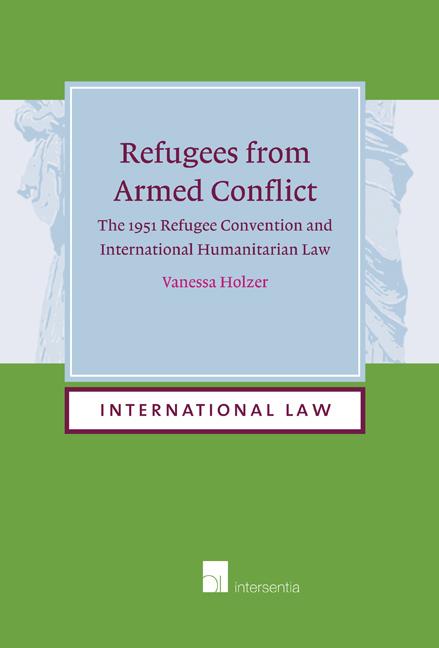Book contents
- Frontmatter
- Dedication
- Acknowledgements
- Contents
- Abbreviations
- Chapter 1 Introduction
- Chapter 2 The Historical Evolution of International Refugee Law in Light of Armed Conflict
- Chapter 3 The International Legal Framework for the Protection of the Individual in Armed Conflict
- Chapter 4 The Interpretation of the Refugee Definition
- Chapter 5 The Well-Founded Fear of Being Persecuted
- Chapter 6 Lack of Protection in the Country of Origin
- Chapter 7 The Nexus to a Refugee Convention Ground in Armed Conflict
- Chapter 8 Conclusion
- Bibliography
Chapter 2 - The Historical Evolution of International Refugee Law in Light of Armed Conflict
Published online by Cambridge University Press: 12 December 2017
- Frontmatter
- Dedication
- Acknowledgements
- Contents
- Abbreviations
- Chapter 1 Introduction
- Chapter 2 The Historical Evolution of International Refugee Law in Light of Armed Conflict
- Chapter 3 The International Legal Framework for the Protection of the Individual in Armed Conflict
- Chapter 4 The Interpretation of the Refugee Definition
- Chapter 5 The Well-Founded Fear of Being Persecuted
- Chapter 6 Lack of Protection in the Country of Origin
- Chapter 7 The Nexus to a Refugee Convention Ground in Armed Conflict
- Chapter 8 Conclusion
- Bibliography
Summary
INTRODUCTION
This chapter situates the Refugee Convention in its historical context. It examines the development of international refugee law in the inter-war period and after the Second World War at the universal level, focussing on the extent to which the refugee definitions in the different instruments adopted during this period encompassed individuals forced to leave their country of origin due to armed conflict.
THE INTER-WAR PERIOD
The early efforts of the international community to devise legal instruments for the protection of refugees stem from several mass exoduses during and after the First World War. The first group of refugees whose protection was addressed under the auspices of the League of Nations were from Russia, with subsequent arrangements concerning Armenian refugees. Towards the end of the interwar period, some measures were also adopted with respect to German refugees fleeing the Third Reich.
ARRANGEMENTS FOR RUSSIAN AND ARMENIAN REFUGEES
The causes of the refugee movement from Russia between 1918 and 1922 were multi-faceted and oft en inter-related; they include the Russian Revolution of 1917 and pursuant Civil War as well as the 1921 famine. The group of Russian refugees was of mixed composition including, for example, members of defeated “White” armies or resistance groups, civilians affected by the hostilities, prisoners of war who refused to return to Russia, political opponents of the Bolsheviks and famine victims. Armed conflict was thus one of several reasons that prompted the Russian refugees to leave their country of origin.
What put all Russian refugees in a difficult situation was their loss of protection by their country of origin. Most of them were formally denationalised in 1921 by the new Soviet government. As a result, the Russian refugees were in a legally anomalous situation. They lacked a secure identity and were unable to travel freely between States. It was hence not the reason for their flight, for example an armed conflict, that prompted the need for international protection, but their lack of State protection and identity documents. The measures adopted under the aegis of the League of Nations for the protection of the Russian refugees were designed to mitigate this legally anomalous situation.
- Type
- Chapter
- Information
- Refugees from Armed ConflictThe 1951 Refugee Convention and International Humanitarian Law, pp. 27 - 40Publisher: IntersentiaPrint publication year: 2015



